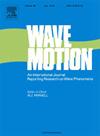对称破缺在旋转晶格中引起极化带隙和异常弹性波行为
IF 2.5
3区 物理与天体物理
Q2 ACOUSTICS
引用次数: 0
摘要
我们研究了基于表面的陀螺晶格的弹性波色散,并分析了引入材料和几何不对称对其行为的影响。首先,我们发现未修饰(高对称)的陀螺晶格在色散关系中表现出多重简并,从而阻止了带隙的形成。为了消除这些简并性,我们实施了两种不对称策略:(1)材料不对称,通过为单元胞的不同区域分配不同的刚度或密度;(2)几何不对称,通过沿坐标轴不均匀缩放晶格来创建各向异性的“陀螺派生”形状。无限周期晶格的Bloch-Floquet分析表明,这两种方法都打开了新的带隙。材料不对称的陀螺仪形成极化方向的带隙,在特定方向上阻挡一个剪切极化,并且对于中等刚度或密度对比,产生“流体状”状态,其中剪切极化(s1和s2)都被强烈衰减,只允许纵波(P)。几何上不对称的陀螺仪同样表现出定向带隙,并且在低频时表现出异常传播:横波相速度超过纵波相速度——与通常的等级相反。计算均质化证实这些异常是由沿某些轴向的各向异性有效刚度系数C44∗和C66∗超过C11∗引起的。总的来说,我们的研究结果表明,在陀螺晶格中故意的材料或几何不对称可以精确地剪裁带隙和波速层次,为设计用于隔振和波控的结构超材料提供了一种有效的方法。本文章由计算机程序翻译,如有差异,请以英文原文为准。

Symmetry breaking induces polarized bandgaps and anomalous elastic wave behavior in gyroid lattices
We investigate the elastic wave dispersion of surface-based gyroid lattices and analyze how introducing material and geometric asymmetry affects their behavior. First, we show that unmodified (high-symmetry) gyroid lattices exhibit multiple degeneracies in their dispersion relations, preventing bandgap formation. To lift these degeneracies, we implement two asymmetry strategies: (1) Material asymmetry, by assigning different stiffness or density to distinct regions of the unit cell; and (2) Geometric asymmetry, by scaling the lattice unequally along coordinate axes to create anisotropic “gyroid-derived” shapes. Bloch–Floquet analysis of the infinite periodic lattices reveals that both approaches open new bandgaps. Material-asymmetric gyroids develop polarized-directional bandgaps that block one shear polarization in specific directions, and for moderate stiffness or density contrast, produce a “fluid-like” regime in which both shear polarizations ( and ) are strongly attenuated, allowing only longitudinal () waves. Geometrically asymmetric gyroids likewise exhibit directional bandgaps and, at low frequencies, display anomalous propagation: shear wave phase velocities exceed longitudinal wave velocities—a reversal of the usual hierarchy. Computational homogenization confirms that these anomalies arise from anisotropic effective stiffness coefficients and surpassing along certain axes. Overall, our results demonstrate that deliberate material or geometric asymmetry in gyroid lattices enables precise tailoring of bandgaps and wave-speed hierarchies, offering an effective approach for the design of architected metamaterials for vibration isolation and wave control.
求助全文
通过发布文献求助,成功后即可免费获取论文全文。
去求助
来源期刊

Wave Motion
物理-力学
CiteScore
4.10
自引率
8.30%
发文量
118
审稿时长
3 months
期刊介绍:
Wave Motion is devoted to the cross fertilization of ideas, and to stimulating interaction between workers in various research areas in which wave propagation phenomena play a dominant role. The description and analysis of wave propagation phenomena provides a unifying thread connecting diverse areas of engineering and the physical sciences such as acoustics, optics, geophysics, seismology, electromagnetic theory, solid and fluid mechanics.
The journal publishes papers on analytical, numerical and experimental methods. Papers that address fundamentally new topics in wave phenomena or develop wave propagation methods for solving direct and inverse problems are of interest to the journal.
 求助内容:
求助内容: 应助结果提醒方式:
应助结果提醒方式:


